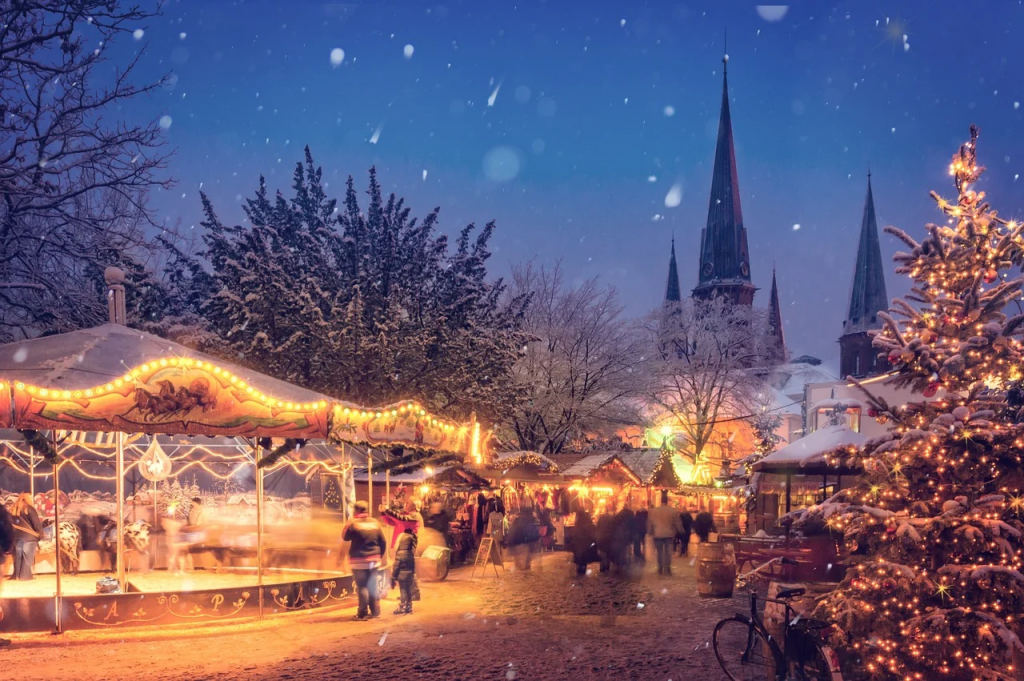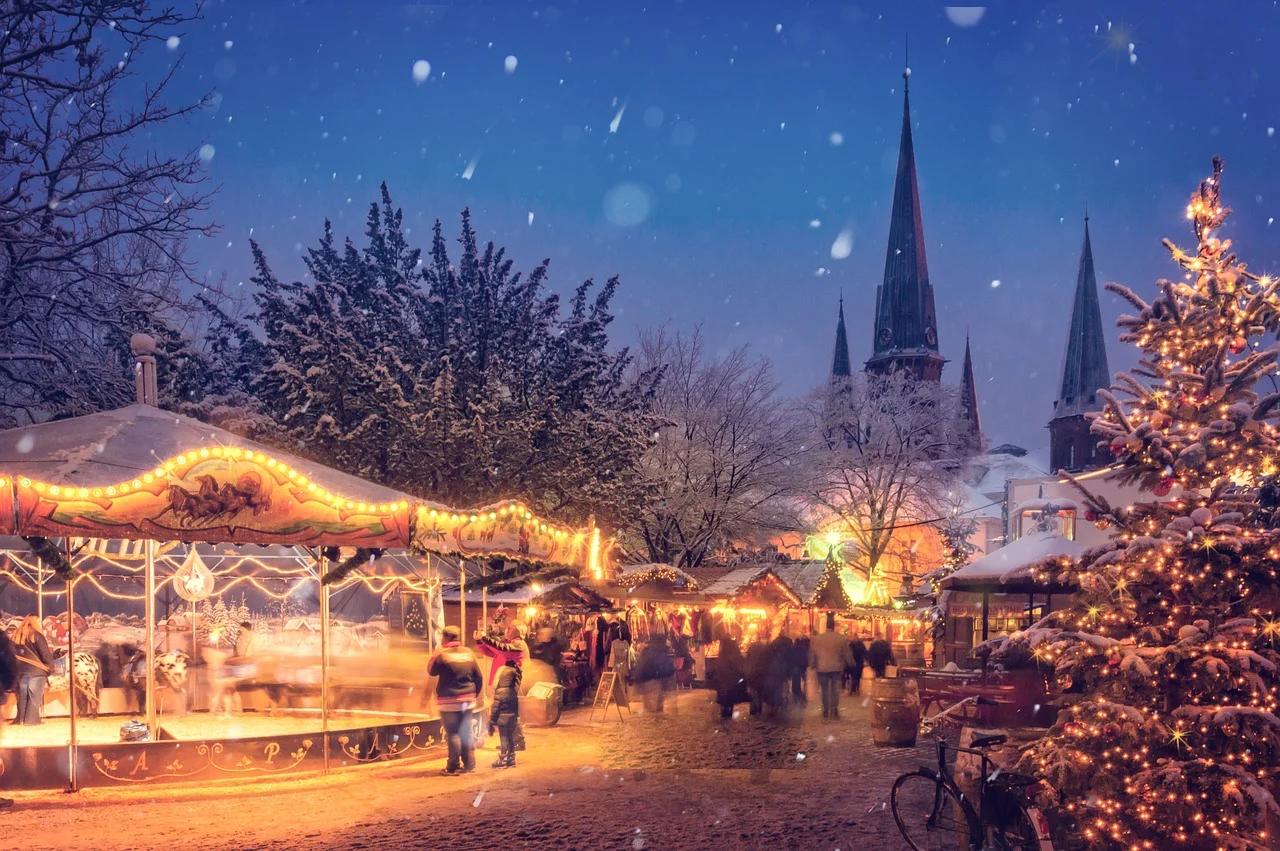
The countries in Europe tend to do more on Christmas Eve than on Christmas Day. Some go to a late-night or midnight church service, some just share a big meal, and most open presents at midnight. Because of this, most establishments do not stay closed for Christmas Day.
Advent calendars are a fun tradition in most of Europe. These are usually three-dimensional objects with 24 compartments, in which each has a small treat or bit of candy. These can be plain rectangles (often decorated as a house or something similar), a train, a wreath, or pretty much anything. Another form of Advent Wreath is the one that holds five candles – one for each week of Advent and one for Christmas Day. Some of the Swiss villages picture homes around town, and on each day, the person whose home is depicted hosts the others in a celebration.
United Kingdom
The UK has a variety of common traditions that are enjoyed every year but are mostly specific to their countries.
Christmas Crackers
These are not a food item; Christmas crackers are cardboard tubes, wrapped in brightly colored foil. Two people sitting side by side each take one end and pull, and the tiny explosive inside makes a pop noise and the prizes are in the center – usually something small and silly – along with a paper crown that is worn briefly.
Mince Pie
This treat – often made in individual tart sized pies – are made from bits of dried fruit and spices. Some may include meat, but not all, despite the filling being referred to as “mincemeat.”
Wassail
A type of mulled cider or mulled wine, wassail’s name means “be well” and was a new year tradition at one time but ended up a holiday treat. Usually served warm, it has fruits and spices infused and is shared cheerfully.
Christmas Pudding
This is not the type of pudding about which most Americans think. In the UK, “pudding” is the term for “dessert.” This is actually a type of heavily spiced fruitcake which is covered with brandy and lit on fire temporarily. Some bakers include coins inside as a bonus gift.
Switzerland
Switzerland has many horse-drawn sleighs that delight visitors and natives alike, with the beautiful background of the Swiss Alps. In Gstaad, a procession with Santa Claus to the church from the Posthotel Rössli is a beloved tradition.
Spain
Spain has an extra holiday during the Christmas season, on December 28th. Known as Holy Innocents’ Day, this is a sort of “April Fools’ Day” in which jokes are played.
Portugal
Portugal’s Penela is home to one of the largest nativity scenes in Europe, featuring animated wooden figures numbering in the hundreds to tell the nativity story. All figures are painted by hand.
Poland
If fish is a favorite food, spending Christmas Eve in Poland may be something fun to do. Referred to as Wigilia, Christmas Eve is when the feast is held, beginning when the stars begin to show in the sky. The meal is usually made up of 12 courses, of which one is carp – more familiarly known as goldfish (but obviously much larger).
Italy
As Italy is home to Rome, where the Vatican resides, it is logical that Christmas is a big holiday there. However, even in Italy, not all of the celebrations are religion-based. Many celebrate 12 days – from Christmas Eve on December 24 until Epiphany on January 6 – which also coincides with the winter solstice festival of previous centuries. However, even though the biggest celebrations start then, events are scheduled as early as December 8, which is known as the Feast Day of the Immaculate Conception.
A Christmas Eve fish dinner is a tradition, after which families may visit a live nativity scene and attend a midnight church service. Many town squares feature a bonfire for gathering around.
Venice and Milan offer Christmas villages, where a whole town is transformed into a festive area with vendors, entertainment, and more.
Rome decorates to honor the birth of Jesus Christ and also features a Christmas Market. Life-size nativities and beautifully decorated trees can be found in many areas of town – one particular one in Saint Peter’s Square is unveiled on Christmas Eve.
The Festival of Torches (or Festival of Nemoralia) was originally honoring the goddess Diana, but the Catholics adopted it and changed it to the Feast of the Assumption. Torchlight processions and Christmas carols make the streets a festive place, and a torchlight procession on the Alps by skiers is quite a sight!
Holland
Holland’s primary tradition has come under some criticism in recent years, as one of Santa’s helpers, known as “Black Pete” (Zwarte Piet) has been traditionally portrayed by a white man in blackface. In some recent celebrations, Pete has changed color to purple or blue, instead.
Greece
Greece may not decorate as much as other countries, but traditions there are unique. Songs known as kalandas have been sung annually since Byzantine times, lending a solemn quality to the holiday.
Their version of Christmas elves, the Kallikantzaroi (sometimes spelled with a C instead of K) are dangerous predators who kick or steal those who are not well behaved. A traditional Yule Log is kept burning throughout the 12 days in many homes. This is meant to keep evil spirits from entering the house through the chimney. Herbs may be suspended as well. The creatures are believed to be banished on Epiphany when the priest blesses the waters.
Germany
Tannenbaum – the Christmas tree – had its roots in Germany. As early as 1605, a Christmas tree was mentioned in German literature. Germany has many Christmas markets throughout the country and offers winter sports during what is sure to be a white Christmas.
France
Some children may be disappointed by receiving no answer to their annual letter to Santa Claus, but children in France do not have this problem. Starting in 1962, all children who write a letter to Santa receive a reply.
Austria
The home of “Stille Nacht” (more familiarly known as Silent Night), Austria has the Salzberg Advent Singing Festival every year in early December. Sleigh rides, beautiful trees, and Christmas markets abound throughout the country.

